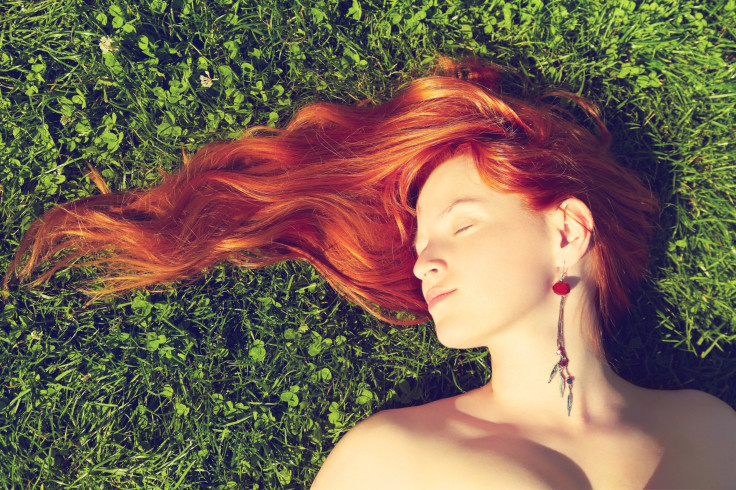8 Ways Having Red Hair Affects A Person's Health, From Pain To Sex

Natural-born redheads have a biology unlike any other. It’s the rarest hair color in the world, and with it comes a unique set of health consequences. Thanks to one genetic mutation and a few other mysterious causes, redheads have different pain tolerances, sexual encounters, and risks for disease than any other person with a different hair color.
8 Health Anomalies of Redheads
1. Might as well be human unicorns
It was only in 2000 that scientists identified the gene responsible for red hair — the melanocortin 1 receptor (MC1R) protein. We all have this gene; however, sometimes the gene mutates, causing the characteristic reddish hue that’s found atop gingers’ heads, along with pale skin and light eyes.
Because MC1R was only discovered 15 years ago, researchers don’t know the exact amount of people with red hair throughout the world. Current estimates put that number between one and two percent of the global population.
2. More sensitive to painkillers
The same MC1R mutation that turns their hair red also releases a hormone in the brain that has the ability to mimic endorphins. Endorphins have several functions, but one of their primary roles is to provide pain relief. This ultimately affects how the body receives pain signals from the brain, causing a heightened sensitivity to prescription opioid painkillers. As a result, redheads can take smaller doses of these drugs to reach the same level of pain tolerance as others.
3. Detect temperature changes more accurately
The same mutation that makes their hair red is also what causes them to be more sensitive to temperature changes — even slight ones. They feel hot and cold temperature changes faster and with greater intensity than those with other hair colors. So, if you’re a brunette standing outside complaining about the cold, your redheaded best friend next to you is probably worse off.
4. Need more anesthesia during surgery
Redheads need 20 percent more anesthesia than their dark-headed counterparts. Because the MC1R gene belongs to the same family of genes that play a role in pain, the mutation causes redheads to be more sensitive to it. MC1R’s role in the brain may affect the activity of endorphins — one of the body’s natural painkillers. New research in the Journal of the American Dental Association reveals that as a result of this, redheads are twice as likely to avoid going to the dentist as people with other hair colors. If they’re not given enough Novocaine, they’re in more pain.
5. They produce their own vitamin D
Northern European countries have the highest concentrations of redheads, and there’s a reason for that. When humans migrated out of Africa tens of thousands of years ago, their skin lightened over time because they were exposed to less sun, according to the BBC . People with darker skin developed it to block some of the sun’s harmful UV rays, but in the process also lost the ability to naturally produce high levels of vitamin D. On the other hand, people with red hair, who don’t get much sun, were able to adapt; their bodies learned to efficiently generate the vitamin D their bodies needed.
6. Increased risk for certain diseases
Unfortunately, redheads are nearly twice as likely to develop Parkinson’s disease when compared to those with darker hair. A 2009 study published in the Annals of Neurology looked at more than 130,000 people over 16 years and found those with red hair had a risk unlike those with dark hair. They’re still not entirely sure why.
They do know, however, why redheads are at an increased risk for melanoma, the deadliest form of skin cancer. The MC1R mutation doesn’t bind to the PTEN gene, which is known to prevent tumors and safeguard against cancer, according to Harvard Medical School . Under normal circumstances, when there is no mutation, the gene will bind and protect the skin from developing cancer cells. When a redhead’s skin is exposed to ultraviolet rays, PTEN breaks down and pigment-producing cells grow quickly, eventually developing into cancer.
7. Redheads rarely go gray
Redheads’ hair initially turns to light copper, then blonde, and finally white, completely skipping over the gray-hair stage. They also tend to retain their pigment longer and typically have thicker hair than other people. Red hair is the most difficult shade to dye and maintain, making it the hardest hair color to fake.
8. More sex
When a redhead walks into a room, there’s a good chance they’ll be noticed, giving them — especially women — a competitive advantage in the mating game, according to research by cognitive science and psychologist Dr. Scott Barry Kaufman. Color psychologists say red provokes arousal more than any other color, and that it’s an indicator of youth and fertility. Thus, it makes sense to align redheads with sex. People are also tend to be attracted to things that are rare, which could also increase redheads' allure.
Source: Barry JD. Red for danger: the effects of red hair in surgical practice. BMJ. 2015.
Ascherio A, Gao X, Simon KC, Han J, and Schwarzschild MA. Genetic determinants of hair color and Parkinson’s disease risk. Annals of Neurology. 2015.



























